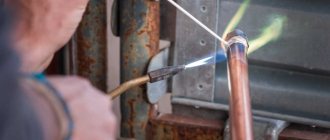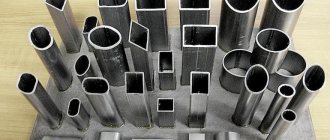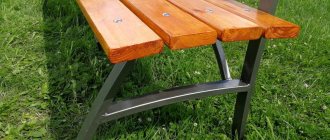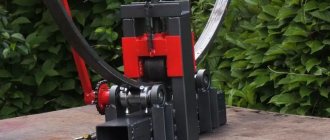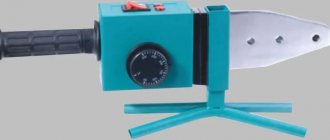Profile pipes of square or rectangular cross-section with a wall of 2 mm are in good demand among the population; in everyday life, they are used to make various types of building structures (gazebos, greenhouses), organize fences, make frames for canopies and canopies. The main method of connecting them is electric arc welding, and if the homeowner has purchased a welding machine and has no experience in carrying out welding work, he will immediately be faced with the question of what electrodes to use to weld a 2 mm profile pipe.
In addition to the selection of suitable electrodes, the quality of welding profile pipes largely depends on adherence to technology, selection of the correct operating modes of the device, knowledge of basic techniques and methods that facilitate the performance of electric welding work by a beginner.
Fig.1 Application of structures made of rolled profiles
Basics of welding corrugated pipes
Profiled pipes are produced with walls of different thicknesses. At the same time, it is most difficult to work with thin-walled rolled metal. To perform the welding process efficiently, you need to have knowledge and experience. Therefore, it is necessary to understand how thin-walled pipes are welded. During this process:
- current used is 10-60 A;
- electrodes with a diameter of 0.5-2 mm are used;
- Only one pass of the electrode is carried out at the junction of the parts.
Welding speed affects the quality of the seam. The process must be completed before the edges of the two workpieces being joined cool down.
Important! Rutile electrodes allow for pull-out welding.
Electrodes with rutile coating Source temir.ru
To make quality connections, you also need to know how to properly weld a profile pipe, regardless of the wall thickness. When carrying out such welding work, it is necessary to take into account that during the process the metal melts and often fills or even completely covers the internal space of the pipe. If it is necessary to maintain the hollowness of the corrugated pipes, it is necessary to ensure that drops do not fall into the internal cavities of the parts being welded.
In addition, profiled pipes are more deformed when exposed to high temperatures compared to similar round products. It is also necessary to ensure the correct formation of the weld bead and evenly heat the metal while making end connections to prevent the appearance of high stress in the corners.
Welding theory
A novice welder is wondering which welding inverter to buy, and what devices are needed for welding metal with electrodes. If we ignore the professional use of welding, buy a welding inverter, not a transformer or semi-automatic machine.
The welding inverter converts alternating current from the electrical network into direct current.
The advantages of an inverter welding machine compared to a semi-automatic machine and a transformer:
- Light weight and dimensions, on average the inverter weighs 3-5 kg.
- Easy to use for beginners.
- Allows you to quickly master welding.
You can talk endlessly about the advantages of inverters, but it’s better to see it once to understand what advantages this type of welding equipment has.
Now we will tell you what kind of process occurs during metal welding and how to evaluate the result. There are two metal blanks of different sizes. A constant voltage from a welding inverter is supplied to the metal through the electrode and ground. For an electric arc to occur, two conductive elements with a plus and a minus are needed. When electrodes of different polarities touch the metal, an electric arc is ignited, releasing high temperature. The metal begins to melt and, at the same time, when moving, the metal rod of the electrode melts with a special coating - coating.
When burned, the coating creates a gas protection for the seam, protecting it from the harmful effects of oxygen.
Also, during welding, a protective slag layer of the weld pool is formed, which is then beaten off with a special hammer from the welder.
After completing the welding of the parts, the metal cools, crystallizes, and a strong welded joint is formed.
Welding methods
Professionals know well how to weld a profile pipe using different methods. Therefore, they quickly and efficiently complete the assigned tasks.
Manual arc welding
This method is often used by specialists. This method is easy to implement. It allows you to get a high-quality seam using available equipment.
Seam after manual arc welding Source content.foto.my.mail.ru
To perform the process, specialists use an inverter or transformer welding machine. To increase the convenience of work, various devices can be additionally used. One of them is magnetic squares. With their help, it is more convenient to weld pipe blanks at the desired angle.
Often specialists also use centralizers. With their help, it is possible to quickly align the axes of the parts when they are connected at the ends. External and internal centralizers are used. One of the varieties are clamps, which allow you to rigidly secure products on a flat surface.
Manual arc welding is used to connect profiled pipe parts with different section sizes and wall thicknesses. If corrugated pipes are made of metal thicker than 4 mm, then their ends are first cleaned and then degreased.
In addition, you also need to know which electrodes to use to weld the profile pipe in order to obtain a strong connection. If the wall thickness does not exceed 4 mm, then rods with a diameter of 2 to 3 mm are used. In this case, the current strength on the welding machine is set in the range from 50 A to 60 A.
Welding electrodes 2.5 mm Source main-cdn.goods.ru
Important! When welding thin-walled corrugated pipes, there is no need to pre-form the edges. In this case, it is necessary to maintain a minimum gap between the parts. Welding processes using the manual arc method are carried out vertically, horizontally and even in the down position.
See also: Catalog of companies that specialize in complex installation of internal engineering systems
Electric arc welding process in shielding gas
Connecting a professional pipe in this way is done using non-consumable electrodes. The method is used for welding thin-walled parts that are pre-cleaned and degreased.
To carry out the process correctly, you also need to know which electrodes to use to weld a 2 mm profile pipe. When connecting such rolled products, tungsten rods are used. Their diameter should be 1 mm. If the wall thickness of rolled metal exceeds 2 mm, then electrodes with a cross-sectional size of 1.6 mm are used.
You also need to choose the correct diameter of the welding wire. This characteristic also depends on the thickness of the metal. If it is 1 mm, then use wire with a diameter of 1 mm to 1.5 mm. When the wall thickness of the corrugated pipe is 2 mm, wire is used whose cross-sectional size ranges from 2 mm to 2.5 mm.
Welding wire for professional pipes Source tck-market.ru
When performing the process itself, professionals hold the electrode at a minimum distance from the welding site. This allows you to create the shortest possible arc, which improves penetration and improves the quality of the welded joint. The electrode is moved only in the direction of the seam. At the same time, they do not make transverse movements.
Important! The supply of filler material is smooth. Otherwise, splashing will occur. In this case, the maximum amount of gas consumed should be 12 l/min.
It is also important to correctly set the current strength when performing electric arc welding of a profile in shielding gas. Its value should be 50-120 A. The choice of value is influenced by the thickness of the metal.
When performing the electric arc welding process in shielding gas, specialists use:
- block and transformer or inverter power source;
- gas burner;
- gas cylinder;
- special rubber hoses;
- gearbox
Equipment for the electric arc welding process Source 8.allegroimg.com
When completing the electric arc welding process, first reduce the voltage. In this case, the gas is not shut off immediately, but only after 15 seconds after turning off the current.
How to choose electrodes
The table below will help you select electrodes for welding a profile tube:
| Pipe wall thickness (mm) | Electrode diameters (mm) | Settable current on the device (A) |
| 2 | 1,5 | up to 50 |
| 2 or 3 | 2 | from 40 to 80 |
| 2 or 3 | 2,5 | from 60 to 100 |
| 3 or 4 | 3 | from 80 to 100 |
| From 4 to 6 | 4 | from 120 to 200 |
| From 6 to 8 | 5 | from 175 to 250 |
| From 10 to 24 | 5 or 6 | From 220 to 300 |
| From 24 to 50 | 8 | from 300 to 400 |
Please note that these values are recommendations!
Before starting work, it is worth carrying out test welding on a separate section of the pipe to check how high-quality the produced seam will be. And after that it will be clear to you which electrodes are suitable for welding.
Video description
The technology of DC welding is described in the video:
The inverter allows you to weld pipes with different wall thicknesses. The equipment is ideal for beginner welders. After all, such modern devices have a pulse mode of operation.
When welding a 2 mm profile pipe with an inverter, the current strength is set in the range from 50 A to 60 A. If thick-walled rolled products are connected, then the craftsmen increase the electric current.
When the electrode makes contact, an electric arc occurs. Coated rods are used in this work. It begins to burn when the arc is excited. As a result, the coating melts. One part of it moves onto the molten metal, and the other goes into a gas state. Therefore, the working area does not come into contact with air.
Welding using an inverter prevents the electrode rod from sticking. In this case, the process is performed with a stable arc, since the equipment used is a source of direct current. This results in a high-quality weld.
Weld from inverter Source instructables.com
Common electrodes for welding corrugated pipes
In the production of profile pipes, low-alloy or carbon steel is often used. Such rolled metal is welded using the following electrodes:
- ANO-4 is a popular brand of electrode rods. This is a universal consumable that does not require pre-calcination. This type of electrode is used with various types of welding machines.
- OZS-12 – rods are designed to produce high-quality seams. However, the disadvantage is low resistance to moisture.
- UONI-13/55 – these rods are used by a large number of professionals.
- MP-3S - these electrodes are used when it is necessary to improve the quality properties of welds.
Features of welding profile pipes at an angle of 90°
Only a specialist will be able to qualitatively connect two parts from rolled pipe at right angles. After all, he has experience and knows all the technology on how to weld a profile pipe at 90 degrees. The professional performs the process in the following sequence:
- both pipes are cut in accordance with the calculated dimensions;
- a flat surface is selected and prepared for work;
- the right angle between two parts is fixed using magnetic squares or scarves;
- a rough connection is made by welding;
- the right angle between the two pipes is checked;
- final welding of rolled metal is carried out.
Welding without burning through a profile pipe
Most often, thin-walled pipe metal is burned through. The reason for this unpleasant situation may be the wrong choice of welding method. You can prevent any mistake if you entrust the work to professionals. After all, they know well how to properly weld a profile pipe so as not to burn through the junction of two parts.
To minimize the likelihood of burning through thin-walled metal, electrodes with a diameter of no more than 1.5 mm are used. In this case, be sure to set a small amount of electric current on the welding machine and select reverse polarity.
It is also recommended to carry out the process with separation. In other words, welding should be done in short sections. It can also be done using the point method. In addition, it is better to insert a metal liner into the pipes, the external dimensions of which are as close as possible to the internal size of the elements being connected.
They also try to minimize the distance between the edges of welded profile pipes. In this case, they strive to move the electrode rod as quickly as possible.
How to avoid profile burning
How to avoid burning a profile pipe when welding video
Burning is most likely when working with a profile with thin walls. You can reduce the likelihood of a defect by choosing the right electrode. Its diameter should be up to 1.5 mm. The current should be minimal and the polarity of the connection reversed.
The following tips will help you avoid burning:
- The arc should be ignited on a tack;
- The electrode is placed at an angle back and passed over the junction at a distance of 10-15 mm;
- The arc is formed so that it is shorter;
- Oscillatory movements are excluded;
- They break the arc not at the end of the joint, but by going back 15-20 mm;
- Splashes from the melt and slag must be removed immediately.
During welding, you must always comply with all technological requirements and choose the right consumables; this approach significantly increases the chances of a perfect connection of the most complex workpieces.
Errors when welding profile pipes video
Welded connection of a professional pipe with a round table
The need to use welding when connecting logs from a profile pipe to metal posts arises when constructing a fence along the perimeter of a private territory. In the process of erecting a fence, a number of issues are resolved. A reliable fence will always be built by specialists. After all, they know well how to weld a 40x20 profile pipe to a round post.
Typically, metal pads are first welded onto supports with a circular cross-section. This can be a section of a channel or corner. Then a cross member made of corrugated pipe is attached to them by welding. During fixation of the lag, corner seams are created. The peculiarity of their execution in the horizontal direction is that the molten metal tends to move from the pillar to the crossbar.
When connecting the support and the cross member, it will not be possible to use the “boat” welding method, because the logs are attached exclusively in the horizontal plane. In this case, the pillars are always placed vertically. Therefore, they cannot be placed in a different position to prevent slag from flowing in front of the arc.
Welding fillet welds using the “boat” method Source ds04.infourok.ru
When creating a fillet weld, there is a high probability of lack of penetration. It can occur at the apex of a corner or on any edge. An unwelded area often appears on a profile pipe when the welding process begins with a vertical support. It is formed due to the flow of molten metal onto the surface of the cross member, which has not yet had time to heat up to the required temperature.
To eliminate the possibility of lack of penetration, specialists begin welding from the log. In this case, the electrode is placed at an angle of 45° relative to the crossbar, and during its movement, slight alternating tilts are made to the vertical and horizontal planes.
Welding a frame made of a profile pipe and round metal posts in this way allows you to create strong seams. They can be single or multi-layered.
Welding a profile pipe to a round post Source stevesiron.com
Process Features
It should be noted right away that profile pipes for welding are very convenient:
- They are made in standard sizes so they can be easily combined.
- Varieties of sections make it possible to choose a part for any structure.
- Uniformity of metal thickness.
- Do-it-yourself welding of profile pipelines is carried out with an even edge and a smooth surface.
Difficulties that arise
- When heated, the workpieces change configuration.
- When connecting the ends, high voltage spots appear at the corners.
- The lumen of the pipe product may be partially blocked by metal that has frozen after heating.
If you carefully study all the complexities of the technology, you can weld the profile yourself without any difficulty.
Briefly about the main thing
Welding of corrugated pipes is carried out with a current of 10-60 A and using electrodes with a diameter of 0.5-2 mm, which often perform only one pass. Craftsmen can use manual arc, electric arc in shielding gas, gas welding. Experts often use an inverter in their work.
One of the most popular electrodes are ANO-4 rods. OZS-12, UONI-13/55, MR-3S are also often used. When welding at 90° is carried out, first make a couple of tacks, and then create the main seam. To avoid burning through the metal, electrodes with a diameter of no more than 1.5 mm are used.
Welding of the corrugated pipe to the pole begins with a horizontally located part. The electrode is held at an angle of 45°, and the rod is moved by alternately tilting it towards the support and the crossbar.
Ratings 0




